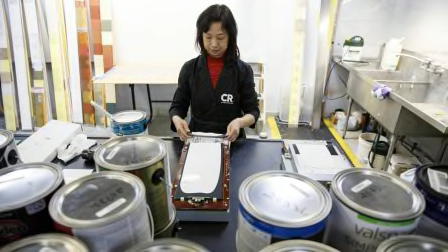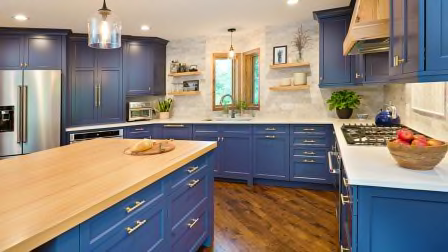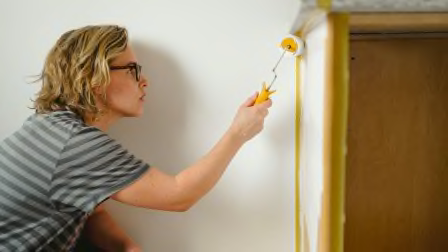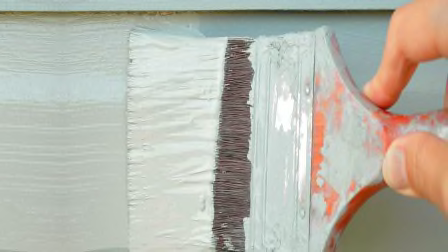How to Paint a Bathroom for Lasting Appeal
Helpful tips from experts, plus the best bathroom paints from CR's tests
When you shop through retailer links on our site, we may earn affiliate commissions. 100% of the fees we collect are used to support our nonprofit mission. Learn more.
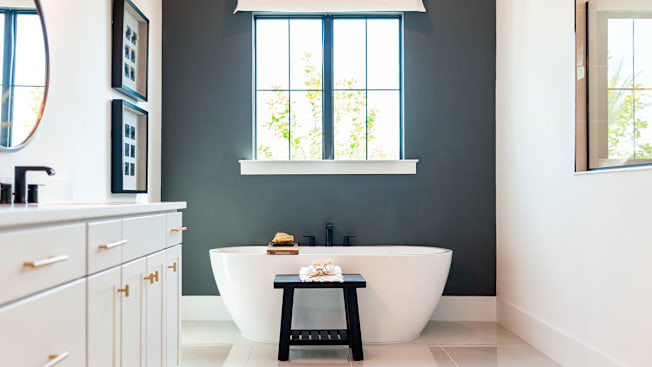
Painting is an inexpensive way to freshen up your bathroom or give it a whole new look. You can turn a moody space into one that’s light and airy, or modernize it with the latest color trends.
Trendy Bathroom Paint Colors
Interior designer Cara Newhart recommends refreshing bathroom paint every five to seven years, depending on where you live and how often the bathroom is used. "Freshening up paint helps keep the room looking crisp and clean and keeps moisture from building up over time," she says.
If you’re in need of bathroom color ideas, Newhart’s go-to for bold bathrooms and powder rooms are Red Pepper and Flagstaff Green from Behr. "I love the adventurous spirit that Red Pepper brings to small spaces," says Newhart. "This vibrant hue promises to spice up any home with its bold and invigorating presence whether used to make a striking statement on the ceiling, accentuated with crisp white trim, or as a daring choice for color drenching to infuse warmth and energy into the facade."

There’s a common misconception that a darker color can shrink a space, but sticking with one shade has the opposite effect.
Color drenching a bathroom is also a favorite technique of Barry Bordelon and Jordan Slocum of the Brownstone Boys. Color drenching involves painting the walls, ceiling, baseboards, and accents in the same tone. "Recently, we’ve been loving a color-drenched, moody bathroom," say the partners in life and design. "There’s a common misconception that a darker color can shrink a space, but sticking with one shade has the opposite effect." To bring the look together—and add some vintage charm—they suggest finishing the space with brass fixtures and hardware. "Overall the look is very refined and distinct," they say.
For primary bathrooms, Newhart often goes neutral to create a more spalike feel. "But neutral doesn’t mean it has to be too light," she insists. The New Jersey-based DIYer’s two favorite picks for larger washrooms are Behr’s Even Better Beige for a dimensional neutral and Havana Coffee for a rich, chocolatey brown. "I love the way Even Better Beige pairs with trending finishes like brass and matte black to help faucets pop," says Newhart. "Havana Coffee is great for an accent wall behind the mirror to create some depth and help ground the room with an earthy shade."
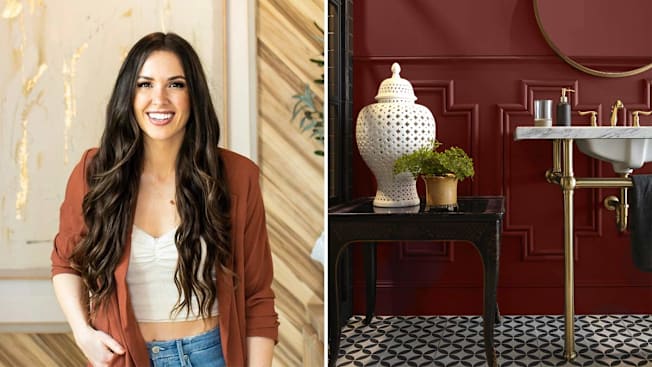
Photos: Cara Newhart Photos: Cara Newhart
Best Paint for Bathrooms
Below are the five top paints from our tests. You’ll notice a number of these paints have Greenguard Gold certification, meaning they emit lower levels of volatile organic compounds, or VOCs—particularly formaldehyde—than the industry standard. VOCs are chemicals that can easily become airborne and affect your health, according to the Environmental Protection Agency. Low levels of VOCs—some manufacturers even claim that their paints have "zero VOCs”—are ideal for interior paint projects.
CR members can check out our full interior paint ratings for details on the 20 different formulas we test, including those from Behr, Benjamin Moore, Kilz, PPG, Sherwin-Williams, Valspar, and more. For more information on interior and exterior paints, see our paint buying guide.
How CR Tests Interior Paints
Using nontinted base paints (paint before color is added), we test how well each one covers dark colors and resists stains. The results show whether a paint hides well enough to not require a primer, and also how well it stands up to wear and tear.
For the coverage test, we apply one consistent coat to a piece of card stock that has been painted black and wait for it to dry. Then, we use a device called a colorimeter to measure how well the paint covers the black paint. We do this twice per paint sample and average the results.
For stain resistance, our testers apply paint to a plastic panel. After it dries, they apply two lines of soil—coffee and a sootlike substance—and allow them to dry. They then wash the painted panels and use a colorimeter to measure the color of the paint on the rinsed areas. The closer the cleaned portions are to the original coat, the more stain-resistant the paint.
Paint a Bathroom Like a Pro
Painting a bathroom can be trickier than painting other areas in your house. Unlike larger rooms where furniture and decorative objects can be moved completely out of the way, in a bathroom there’s a lot more maneuvering you have to do as you paint around fixtures like sinks, toilets, tubs, and showers. To get a professional look, even if you’re opting to DIY, follow these helpful tips:
Play with color. Paint manufacturer websites often have tools that allow you to download a photo of your room, then select wall colors until you find a look you like. Think about your bathroom vanity, too, and whether it needs a fresh coat of paint. For a bathroom next to a bedroom, consider a color that works well with the bedroom paint color, perhaps a shade that’s lighter or darker. And if white is your go-to color, make sure you pick the right white paint.
Choose the right finish. Satin is more durable and shinier than eggshell and is ideal for a bathroom. It’s also easy to clean. Use it for the walls, ceiling, and even the trim, because many satin finishes are tougher than they once were. Semi-gloss is even tougher and a cinch to clean. It can be used on the walls, ceiling, trim, and vanity—if you don’t mind a shinier look. A satin sheen draws attention to any imperfections on the walls (semi-gloss does so even more), so be sure to prep the walls to get them as smooth as you can.
Wash the walls first. New paint needs a clean, dry surface to adhere to. Existing mildew can prevent fresh paint from properly sticking and can even bleed through the new coat. Remove mildew with a sponge dipped in a solution of one part bleach to three parts water. The room should be well-ventilated while you clean, so open a window or run an exhaust fan. Wipe down the surface with clean water and allow it to dry before painting.
Protect what you aren’t painting. With all their nooks and crannies, small bathrooms can be a challenge to paint. Apply painter’s tape to the edges of areas you don’t want painted. And use a sash brush with a tapered tip. Unlike the bristles on a flat brush, those on a sash brush are cut at a diagonal, making it easier to control.
Paint, then wait. Once you’re done applying the paint, let it dry overnight before using the shower. Otherwise, any water that splashes up or beats down on the newly painted surface can cause the paint to soften and run.





























